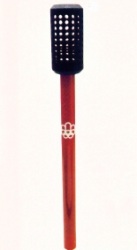Torch and Torch Relay
| The Torch
Being a primary symbol of the Olympic Games, the Flame demands an appropriate setting. With this uppermost in mind, Georges Huel and Michel Dallaire of COJO's Graphics and Design Directorate set out to create the torch that would carry the Flame. Its design was functional. The torch was made of aluminium, and its weight did not exceed 836 grams, a significant factor as each bearer had to run one kilometre holding it with one hand. The top of the torch was designed to provide the required ventilation for the fuel. Painted black, it offered a contrast that accentuated the Flame's photogenic qualities. In its function and design, this torch was a reminder of the ancient Greek torch, recreated in modern and refined lines. 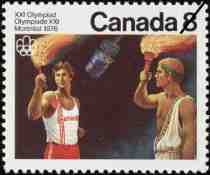
There were at least three replacement flames per convoy: one burning propane gas (researched and designed by the chief armorer), and two burning a commercial lamp oil. Three replacement flames were also maintained throughout the duration of the Games, at the Olympic Stadium and at the operations centre located at COJO headquarters, so that the urn could be relit with the original Flame if necessary. The Torch-bearers and Escorts More than 700 persons were chosen to relay the Flame from Ottawa to Montréal, and from there to Kingston where the yachting competition was held. Those who were not chosen as bearers could be part of the escort that accompanied the torch-bearers from one kilometre to the next. |

|
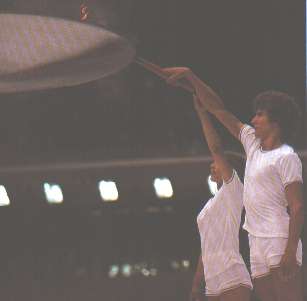
|
Since 1936, the torch-bearers have been chosen from among athletes of the countries along the Flame's route. An innovation for the Montréal Games was the selection of bearers by computer, which took into account the aforementioned criteria. Finally, every bearer and escort in Greece
and Canada received, at the end of the relay, a certificate signed by the
presidents of COJO and the HOC attesting to their participation in the
Flame Relay of the Games of the XXI Olympiad. The uniform, consisting of
a T-shirt bearing the COJO emblem and shorts, remained the property of
the bearer, together with the torch. Several months before the Games, COJO
published a pamphlet entitled Flame Bearer's Guide. Protection of the Flame There were at least three replacement flames
per convoy: one burning propane gas (researched and designed by the chief
armorer), and two burning a commercial lamp oil. Three replacement flames
were also maintained throughout the duration of the Games, at the Olympic
Stadium and at the operations centre located at COJO headquarters, so that
the urn could be relit with the original Flame if necessary. The Fuel Investigations on fuel to feed the Flame were
entrusted to Dr. Lucien Piché of the University of Montréal
Chemistry Department. After study, the researchers chose olive oil because
it contained all of the characteristics required, while evoking a tradition
that linked it to ancient Greece. But first it had to be produced in a
form that could be handled safely by bearers relaying the torch hundreds
|
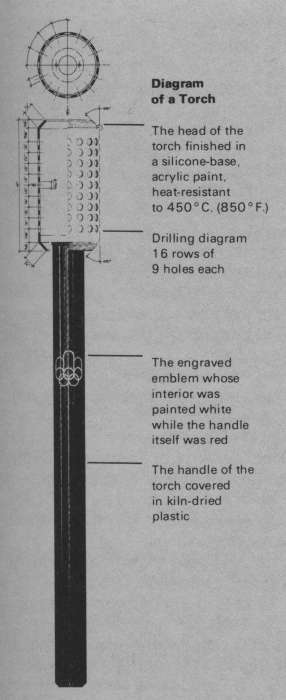 |
Other criteria governing the composition of the fuel were as follows: a) it had to ensure rapid lighting of one
torch from another at each relay; |
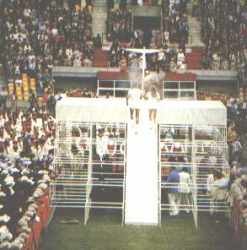
| Description: | Stem painted red, with Montreal logo, top painted black. |
|---|---|
| Material | Aluminium |
| Fuel: | Olive oil with octane |
| Torch measure: | Lenght: 66 cm Weight: 836 gr |
| Torches total: | 1,250 |
| Design by: | Georges Huel and Michel Daillaire |
| Manufacturer: | Queensway Machine Products |
| Date of the torch relay: | 13. Juli - 17. Juli 1976 |
| Duration: | 5 days |
| Numbers of runners: | abfout 1,200 |
| Distance total: | 775 km |
| Name of the last runner: | Stéphane Préfontaine and Sandra Henderson |
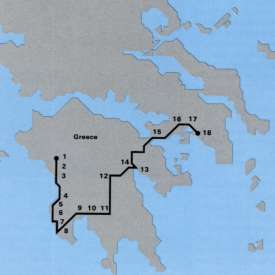 Program in Greece - Olympia-Athens
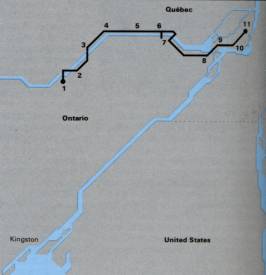 Relay Stages - Ottawa-Montréal
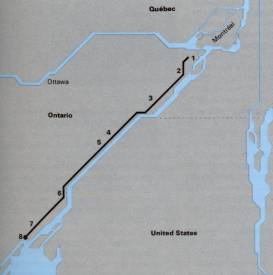 Relay Stages - Montréal-Kingston
Source document: Official
Report 1976, Vol. 1, page 282) |
